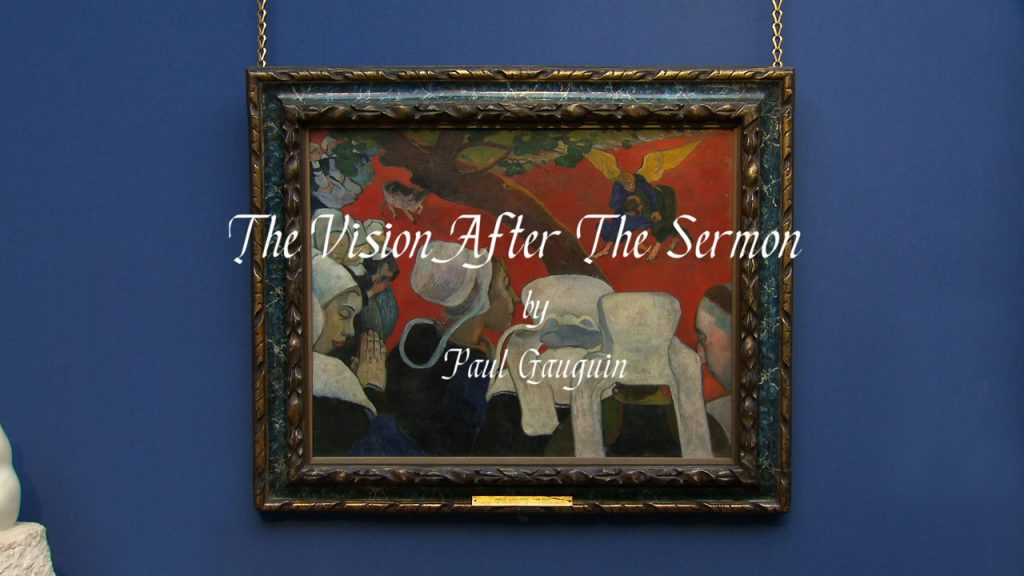The Art Mysteries with Waldemar Januszczak episode 3: The Vision After the Sermon is a painting full of symbolism and mystery. But what does Gauguin’s famous work have to do with a 17-year-old girl called Madeleine, with Victor Hugo’s Les Miserables, and with sumo wrestlers?
Waldemar Januszczak reveals all as he investigates Gauguin’s epic religious painting about good and evil, temptation and desire. Documentary series in which Waldemar Januszczak sets out to uncover the secret meanings hidden in four famous paintings by Van Gogh, Gauguin, Cezanne and Seurat.
The Art Mysteries with Waldemar Januszczak episode 3
Paul Gauguin
Eugène Henri Paul Gauguin was a French Post-Impressionist artist. Unappreciated until after his death, Gauguin is now recognized for his experimental use of color and Synthetist style that were distinct from Impressionism. Toward the end of his life, he spent ten years in French Polynesia. The paintings from this time depict people or landscapes from that region.
His work was influential on the French avant-garde and many modern artists, such as Pablo Picasso and Henri Matisse, and he is well known for his relationship with Vincent and Theo van Gogh. Gauguin’s art became popular after his death, partially from the efforts of dealer Ambroise Vollard, who organized exhibitions of his work late in his career and assisted in organizing two important posthumous exhibitions in Paris.
Gauguin was an important figure in the Symbolist movement as a painter, sculptor, printmaker, ceramist, and writer. His expression of the inherent meaning of the subjects in his paintings, under the influence of the cloisonnist style, paved the way for Primitivism and the return to the pastoral. He was also an influential proponent of wood engraving and woodcuts as art forms.
Vision After the Sermon
Vision after the Sermon (Jacob Wrestling with the Angel) is an oil painting by French artist Paul Gauguin, completed in 1888. The paint it is now in the Scottish National Gallery, Edinburgh. It depicts a scene from the Bible in which Jacob wrestles an angel. The paint depicts this indirectly, through a vision that the women depicted see after a sermon in church. It was painted in Pont-Aven, Brittany, France.
In the early part of his career as a painter, Gauguin had painted primarily landscapes en plein air in the Impressionist manner. By 1888, he had become dissatisfied with Impressionism, which did not satisfy his enthusiasm for archaic and primitive forms or his interest in the mystical. In 1888, during a visit to the artist’s colony of Pont-Aven in Brittany, he met the young artist Émile Bernard, who had begun painting in a simplified style influenced by Japanese prints. Following Bernard’s example but developing it further, Gauguin painted Vision After the Sermon, which marked his interest in interpreting religious subject matter in a highly personal way. He became recognized as the leader of a new style called Synthetism.
The use of color, shape, and line in Vision After the Sermon is appreciated for its bold manner of handling paint. Finding inspiration in Japanese woodblock prints from Hiroshige and Hokusai, which he owned, Gauguin developed the idea of non-naturalistic landscapes. He applies large areas of flat color to the composition, and the red ground departs from conventional representation of earth, field, or grass. In portraying the watching figures Gauguin experiments with the distortion of shapes, exaggerating features, and use of strong contour lines rather than gradual shifts in tone that most painters practiced.
The brown trunk, black garments, white hats and red field are painted with minimal color shading. Gauguin is showing it is possible to move away from naturalism towards a more abstracted, even symbolic, manner of painting. While formal elements of Gauguin’s paintings reflect the influence of Japanese prints, his choice of subject matter and composition are uniquely his own.




